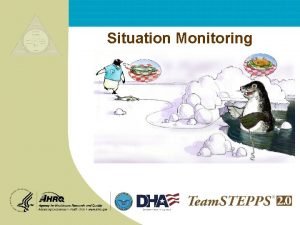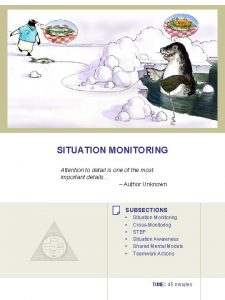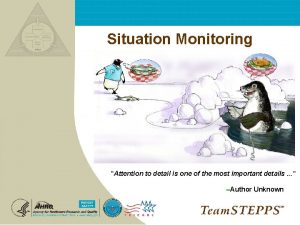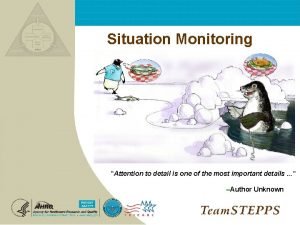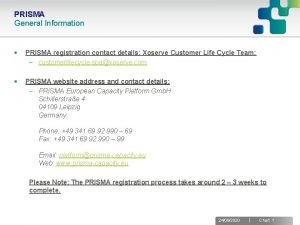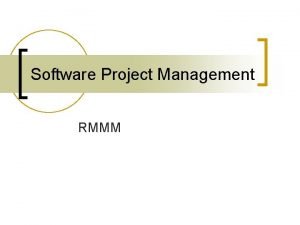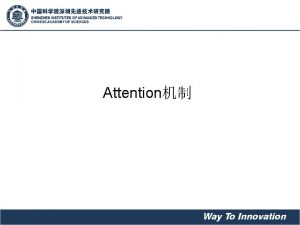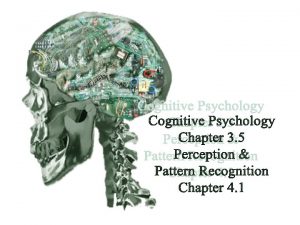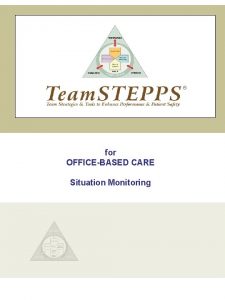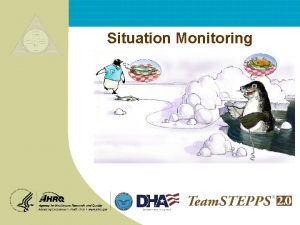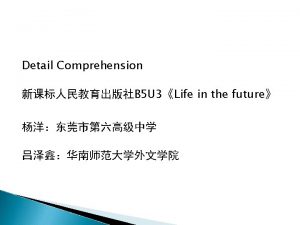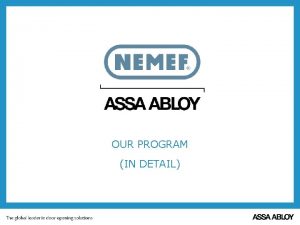Situation Monitoring Attention to detail is one of

























- Slides: 25

Situation Monitoring “Attention to detail is one of the most important details. . . ” –Author Unknown ™

Situation Monitoring ™ Objectives n Define situation monitoring n Define cross monitoring n Discuss the components of the STEP process n Define situation awareness (SA), and identify conditions that undermine SA n Discuss the importance of a shared mental model n Discuss when to share information n Recognize the barriers, tools, strategies, and outcomes of situation monitoring Mod 4 06. 1 Page 2 TEAMSTEPPS 05. 2 2

Situation Monitoring ™ Scenario A patient in the ICU has coded, and CPR is in progress. The Resuscitation Team is busy ensuring that intravenous access is available, and the ET tube is inserted correctly. Dr. Matthews, the Team Leader, is calling out orders for drugs, X-rays, and labs. Judy, a nurse at the bedside, is inserting an IV. Nancy, another nurse, is drawing up meds. Judy can tell by Nancy’s expression that she didn’t get the last order called out by Dr. Matthews. Judy calls out while continuing to place the IV, “Nancy, he wants the high-dose epinephrine from the vial in the top drawer. ” Mod 4 06. 1 Page 3 TEAMSTEPPS 05. 2 3

Situation Monitoring ™ Mod 4 06. 1 Page 4 TEAMSTEPPS 05. 2 4

Situation Monitoring ™ A Continuous Process Situation Monitoring (Individual Skill) Situation Awareness (Individual Outcome) Shared Mental Model (Team Outcome) Mod 4 06. 1 Page 5 TEAMSTEPPS 05. 2 5

Situation Monitoring ™ Situation Monitoring (Individual Skill) Process of actively scanning behaviors and actions to assess elements of the situation or environment n Fosters mutual respect and team accountability n Provides safety net for team and patient n Includes cross monitoring … Remember, engage the patient whenever possible. Mod 4 06. 1 Page 6 TEAMSTEPPS 05. 2 6

Situation Monitoring ™ Cross Monitoring is… Process of monitoring the actions of other team members for the purpose of sharing the workload and reducing or avoiding errors n Mechanism to help maintain accurate situation awareness n Way of “watching each other’s back” n Ability of team members to monitor each other’s task execution and give feedback during task execution Mutual performance monitoring has been shown to be an important team competency. (Mc. Intyre and Salas 1995) Mod 4 06. 1 Page 7 TEAMSTEPPS 05. 2 7

Situation Monitoring ™ Cross Monitoring Mod 4 06. 1 Page 8 TEAMSTEPPS 05. 2 8

Situation Monitoring ™ Mod 4 06. 1 Page 9 TEAMSTEPPS 05. 2 9

Situation Monitoring ™ Components of Situation Monitoring: Mod 4 06. 1 Page 10 TEAMSTEPPS 05. 2 10

Situation Monitoring ™ Status of the Patient § § § Mod 4 06. 1 Page 11 TEAMSTEPPS 05. 2 Patient History Vital Signs Medications Physical Exam Plan of Care Psychosocial Condition 11

Situation Monitoring ™ Team Members § § § Mod 4 06. 1 Page 12 TEAMSTEPPS 05. 2 Fatigue Workload Task Performance Skill Level Stress Level 12

Situation Monitoring ™ I’M SAFE Checklist I = Illness M = Medication S = Stress A = Alcohol and Drugs F = Fatigue E = Eating and Elimination An individual team member’s responsibility … Mod 4 06. 1 Page 13 TEAMSTEPPS 05. 2 13

Situation Monitoring ™ Environment § § § Mod 4 06. 1 Page 14 TEAMSTEPPS 05. 2 Facility Information Administrative Information Human Resources Triage Acuity Equipment 14

Situation Monitoring ™ Progress Toward Goal § Status of team’s patient(s)? § Goal of team? § Tasks/actions that are completed or that need to be done? § Plan still appropriate? Mod 4 06. 1 Page 15 TEAMSTEPPS 05. 2 15

Situation Monitoring ™ Situation Monitoring n Think about examples of situation monitoring, in which you needed to— n Be aware of what was going on n Prioritize and focus on different elements of the situation n Share this information with others n Select one or two that best represent the concept of situation monitoring n Share Mod 4 06. 1 Page 16 TEAMSTEPPS 05. 2 16

Situation Monitoring ™ Situation Awareness is… The state of knowing the current conditions affecting the team’s work n n Mod 4 06. 1 Page 17 Knowing the status of a particular event Knowing the status of the team’s patients Understanding the operational issues affecting the team Maintaining mindfulness TEAMSTEPPS 05. 2 17

Situation Monitoring ™ Conditions that Undermine Situation Awareness (SA) Failure to— Mod 4 06. 1 Page 18 n Share information with the team n Request information from others n Direct information to specific team members n Include patient or family in communication n Utilize resources fully (e. g. , status board, automation) n Document TEAMSTEPPS 05. 2 18

Situation Monitoring ™ A Shared Mental Model is… The perception of, understanding of, or knowledge about a situation or process that is shared among team members through communication. “Teams that perform well hold shared mental models. ” (Rouse, Cannon-Bowers, and Salas 1992) Mod 4 06. 1 Page 19 TEAMSTEPPS 05. 2 19

Situation Monitoring ™ Shared Mental Model? Mod 4 06. 1 Page 20 TEAMSTEPPS 05. 2 20

Situation Monitoring ™ How Shared Mental Models Help Teams n Help ensure that teams know what to expect, so if necessary, can regroup to get on the “same page” n Foster communication to ensure care is synchronized n Ensure that everyone on the team has a picture of what it should look like n Enable team members to predict and anticipate better n Create commonality of effort and purpose “ Shared mental models help teams avoid errors that place patients at risk. ” Mod 4 06. 1 Page 21 TEAMSTEPPS 05. 2 21

Situation Monitoring ™ What Do You See? Mod 4 06. 1 Page 22 TEAMSTEPPS 05. 2 22

Situation Monitoring ™ When to Share? n Briefs n Huddles n Debriefs n Transitions in Care. . . Share information as soon as possible when a change occurs in the patient’s status. Mod 4 06. 1 Page 23 TEAMSTEPPS 05. 2 23

Situation Monitoring ™ Situation Monitoring BARRIERS n Hierarchical Culture n Lack of Resources or Information n Ineffective Communication n Conflict n Time n Distractions n Workload n Fatigue n Misinterpretation of Data n Failure to Share Mod 4 Information 06. 1 Page 24 TOOLS and STRATEGIES OUTCOMES n Situation Brief Huddle Debrief STEP Awareness n Shared Mental Model n Adaptability n Team Cross Monitoring TEAMSTEPPS 05. 2 Orientation n Mutual Trust 24

Situation Monitoring ™ Teamwork Actions n Conduct team exercises to increase situation monitoring skills n Share information in a timely fashion n Include patient and/or family in communication n Use cross monitoring n Apply the STEP process when monitoring the situation n Foster communication to ensure that all members of the team have a shared mental model n Share information during briefs, team huddles, debriefs, and transitions in care “Teams do not seek consensus; they seek the best answer. ” –Katzenbach and Smith Mod 4 06. 1 Page 25 TEAMSTEPPS 05. 2 25
 Minor details examples
Minor details examples Minor and major details
Minor and major details Michelle benjamin phd
Michelle benjamin phd Mod exercise
Mod exercise Situation monitoring examples
Situation monitoring examples Situation monitoring examples
Situation monitoring examples Monitoring the situation
Monitoring the situation Telling detail
Telling detail Xoserve-detail-page-one (xoserveservices.com)
Xoserve-detail-page-one (xoserveservices.com) One empire one god one emperor
One empire one god one emperor One one one little dogs run
One one one little dogs run One king one law one faith
One king one law one faith One empire one god one emperor
One empire one god one emperor One ford
One ford See one do one teach one
See one do one teach one See one, do one, teach one
See one, do one, teach one Twelfth night speeches
Twelfth night speeches See one do one teach one
See one do one teach one Asean tourism strategic plan
Asean tourism strategic plan Asean one vision one identity one community
Asean one vision one identity one community Adverb in detail
Adverb in detail Concrete sensory
Concrete sensory Added-detail fragment
Added-detail fragment Explain rmmm in software engineering
Explain rmmm in software engineering Skimming and scanning images
Skimming and scanning images Parapet roof
Parapet roof



